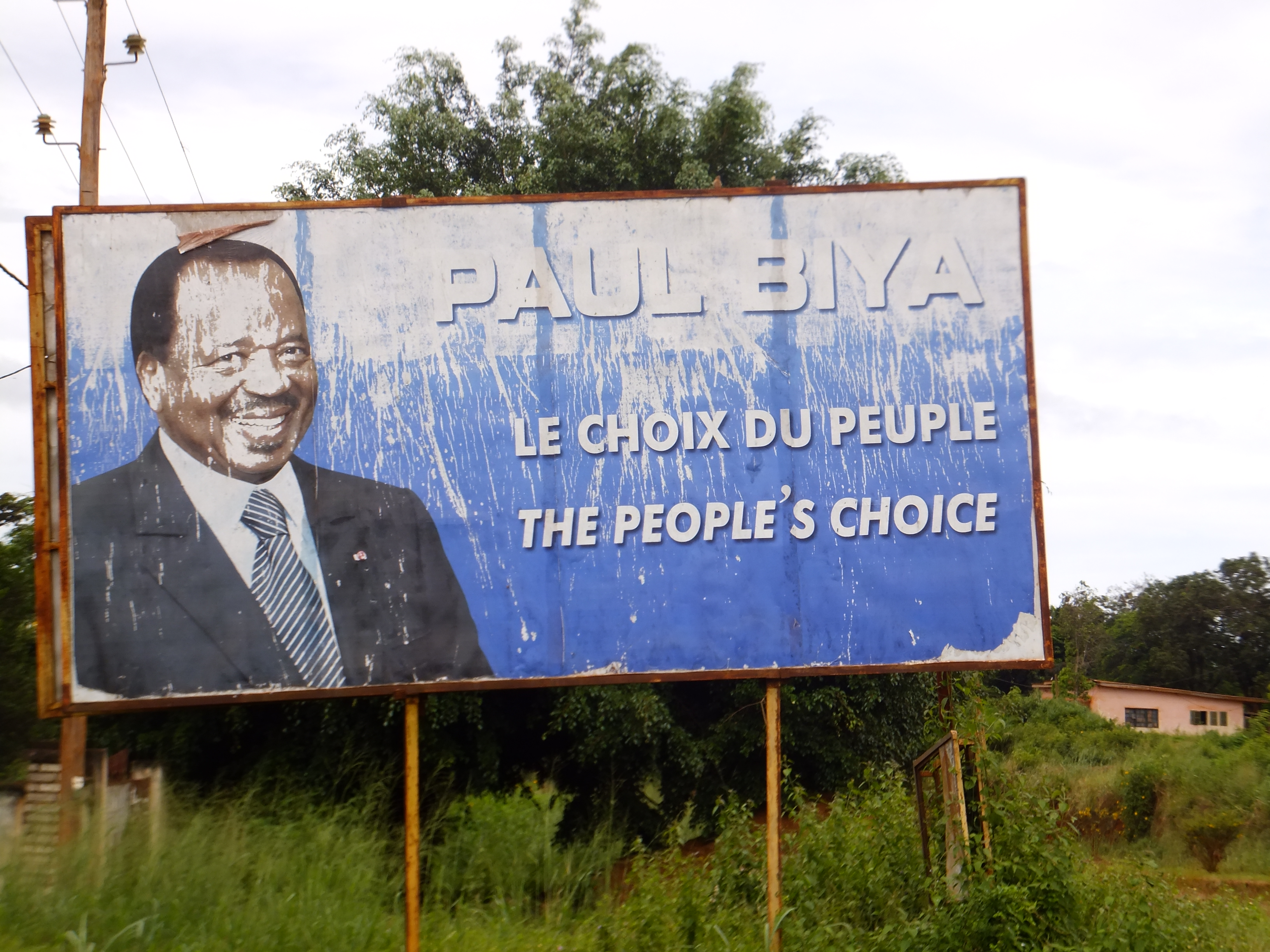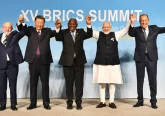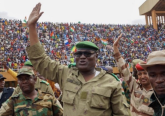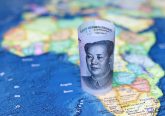The 6th of November 2012 marks the 30th anniversary of Paul Biya’s presidency (1982 – 2012) in Cameroon. Celebrations, dinners, galas and voter registration drives for members of the ruling RDPC party (Rassemblement Démocratique du Peuple Camerounais) are taking place in cities across the country, most predominantly in the central regions, i.e. those with geo-political links and a common socio-cultural heritage (more generally but problematically referred to as ‘ethnic’ ties) to the ruling party.[1] Towns like Mfou, Nanga-Eboko, Nyong, Kelle and Mbam celebrated their political fidelity to President Biya, according to a multi-page report in honour of the event, published by the national newspaper, the Cameroon Tribune.
Local TV stations, including Cameroon Radio Television (CRTV) and Cannal 2, hosted lengthy and oftentimes intense debates for the occasion; issues have included maintaining domestic peace, economic development, press freedom, unemployment and infrastructure. A foundational impetus for the dialogue has been to either defend or disprove that Biya has ‘done something’ or at least ‘done enough’ in his 30 years of power. Cannal 2 invited ‘le fils caché’ (the hidden son) of President Biya, Gilbert Baongla, to participate in a discussion last Sunday evening. During the heated discussion (watch some of it here) he revealed his interest in joining the political arena. Perhaps he’ll compete against his brother, Frank Emmanuel Biya, who has long been speculated as a possible successor to his father.
Politics in Cameroon remain a genre of ‘les politique du ventre‘ (‘politics of the belly’): An ongoing dictatorship characterised by personal enrichment for politicians and their cronies; in this system, politics is a time to eat and eat well. In Cameroon the regime is defined by the relative absence of the leader. By this I refer to the visible invisibility of the dictator, who is jokingly ‘more outside his country than in it’ and who is rarely seen physically or publicly by the people – indeed, Biya does not grant interviews, either domestically or internationally – but who exists everywhere in image. Symbols of the ruling party and the president – including pagnes (clothing fabric/ tissue) decorated with RDPC insignia and the face of the president, campaign T-shirts from every campaign of the last 25 years (given free of charge to Cameroonians as an impetus to vote for Biya), official Biya portraits in every public office, campaign posters in private homes and businesses, billboards of Biya’s grinning face at the entrances and exists of most towns – abound. The president himself is rarely seen outside these static images.
I was locked in a café for approximately four hours a month ago in Yaoundé when the café I was eating lunch in had to lock its doors. The president’s long convoy of black and white gleaming vehicles raced by on official business. Stores and streets shut down, indeed entire quarters of the political capital, Yaoundé, were blocked off. I was told by an indignant business owner that this forced closing sometimes lasts for an entire day, creating a significant loss of revenue for those in the sector. Taxi men and private vehicles sit idle on the roadsides for the duration, not being permitted to advance or return. People gather at the roadside off-licenses to pass the time and wait. It is through such experiences that Cameroonians have contact with the president.

Many of my young Cameroonian colleagues and friends – les chômeurs éduquée (the educated unemployed) – have known no other president. He is often referred to as ‘the father’ or, more humorously for those speaking, ‘the grandfather’. In cafés and taxis I hear jokes of the ‘entire political body’ jailed in the maximum security prisons of Kondengui and New Bell: ‘They need only add a head of state to make a complete ruling government!’ The witticism refers to the regime’s propensity to imprison political leaders, former allies and opposition party leaders alike. In the 2011 presidential election, the opposition was chronically, methodologically and strategically divided, with 23 candidates running. Biya invites his most renowned political adversaries to dine with him at the presidential palace, he pays opposition parties to present candidates for presidential elections and he plays ministers against each other (see Fanny Pigeaud 2011).[2]
Many Cameroonians reveal that voting for Biya is a means to maintain peace. The argument goes something like this: There is a certain amount of safety in what is known, even if what is known is a combination of political repression, nepotism, economic depression, chronic unemployment and underemployment, infrastructural disrepair, labor exploitation and corruption. In this way of thinking, the political unknown is potentially violent and confrontational. There is a common sentiment in Cameroon that if the Beti ‘ethnic’ group (Biya’s Bulu ‘ethnic’ group is a subgroup of the Beti) were to cede political power, violence would ensue.[2] There is a formidable distrust between two of the major ‘ethnic’ groups, the Beti and the Bamilike. Much of this mistrust was cultivated during French colonisation as groups were pitted against each other in divide-and-conquer fashion. The Bamilike have been systematically politically ostracised and were openly persecuted in the central regions in the 1990s and as recently as 2006.[3] Bamilike businesses, homes and farm plots were destroyed as they were told to ‘go home’ by their Beti neighbours. The Anglophone minority in Cameroon has likewise been socially and politically marginalised (see below) and often the two groups are unified in ethnocentric derision: The ‘Anglo-Bamis’.
These are the personal histories that Cameroonians recall when they consider the possible outcomes of regime change. Add to this the awareness that Cameroonians have of violence in post-conflict situations in other countries, particularly the recent unrest in Cote d’Ivoire, and many Cameroonians opt out of voting or continue to vote for the current party. In this context, it is important to understand that for the most part Cameroonians have a comprehensive political consciousness, a collective anger at political abuse and the will for political change but that political circumstances impede peaceful demonstration and the (sense of the) possibility for a peaceful power transition. The question that remains, then, is a highly contentious and personal one: What is the price of peace?
Resistance and the Disappearing of History
Cameroon has a lengthy history of political and social repression, beginning with pre-colonial contact with European explorers in the 16th century, the transatlantic slave trade, forced labour and colonisation (first as a German protectorate until the end of WWI, and then divided among the French and British into two colonised Cameroons). In 1948 an anti-colonial, independence rebellion (1948 – 1971), led by the Union des Populations du Cameroun (UPC), resulted in bloody repression by French troops. The independence movement quickly turned into guerrilla warfare as French troops occupied and raided the Western region of Cameroon. What followed was the massacre of 400,000 Bamilike people (see Deltombe, Momerque, Tatsitsa 2011).[4] This genocide of the people of Western Cameroon has never been acknowledged by French political leaders and stories of the independence movement have been transformed in the Cameroonian popular political imagination as ‘trouble making maquisards’.[5]

I commend Peter Wuteh Vakunta for his insightful and scathing feature in Pambazuka News last week titled, ‘Unraveling the leadership conundrum in Cameroon.’ The article calls for a progressive leadership and is critical of the contemporary political system, particularly corruption and misuse of national revenue for personal enrichment. To his article I would add a more nuanced understanding of the international impetus which has played a heavy hand in determining the political history of Cameroon. For example, Cameroon’s first president, Amadou Ahidjo, did not spontaneously ‘emerge out of a dual colonial contraption’ but was selected by the departing (a term employed loosely here) French colonialists, precisely because of his apparent malleability. Moreover, absent from Vakunta’s account is a sense of the powerful international financial and political apparatus which support and profit from corrupt political regimes.
What is immediately remarkable for our conversation here is the erasing of Ahidjo’s presidency from the Cameroonian political and social scene following Biya’s accession to power. This included outlawing Ahidjo’s name in the media, removing bank notes featuring his image and renaming public spaces that bore his name; all this and Biya was Ahidjo’s self-selected replacement. Ahidjo is joined by a handful of other Cameroonian political and opposition leaders (note Ahidjo was not traditionally the latter although Biya loyalists attribute him with a failed coup d’etat in 1984) – Felix Moumie, Ruben Um Nyobe (both were former leaders of the UPC and both were assassinated by the French military) and Ernest Ouandie to name a few – whose histories have been masked by a forceable silence in the public collective memory. This – Cameroonian intellectual and citizen journalist, Dibussi Tande, argues – impedes national healing. A national healing that is necessary to build a more inclusive and human-centred politics.
When Vakunta argued in his piece in Pambazuka that, ‘The only thing that we [Cameroonians] learn from experience is that we learn nothing from experience. Cameroonians have turned out to be like a bunch of stage clowns who bump their heads into the same obtrusive obstacles again and again because they are too dumb to remember what hit them only a short while ago’, he forgot to take into consideration the conscious erasing of resistance stories by the regimes in power – a disappearing that began during colonialism, which continued during the Ahidjo regime and which continues under the regime in power today. He forgot to acknowledge the lengthy history of rebellion, revolution and resistance in Cameroon.
A (very short) History of Recent Organised Resistances
In 1990, 2,000 troops were sent by the government to break-up a SDF-led peaceful march of 20,000 people in the Northwest Province, known as the Anglophone region (that area of Cameroon formerly colonised by the British). The people demanded the end of one party rule. Paramilitary troops used tear gas and live rounds on the protestors. Six young people were killed in Bamenda and 300 were arrested in Yaoundé.
The government’s legalising of opposition parties in December 1990 (which were outlawed by Ahidjo in 1976) was marred with a wave of violent repression, particularly in the Anglophone region. Protests and subsequent repression of protestors occurred in Douala, Yaoundé, Bamenda, Ngaoundere, Maroua, Bafoussam and Kumba. Rioting at the University of Yaoundé was fierce and human rights activists reported multiple student deaths (with some reports saying as many as 48 died). On May 6th 1991, students fled the university as the gendarmerie raided the campus looking for opposition sympathisers. Two people were killed and 219 people were arrested (according to Radio Cameroon). In Douala one week later, tens of thousands of demonstrators confronted government troops; four people were killed.
John Fru Ndi, the SDF presidential candidate, is widely believed to have won the 1992 presidential election. After the announcement that Fru Ndi had won, he was quickly placed under house arrest. The Northwest Province was placed under a state of emergency as armed forces moved in to occupy towns. Mass arrests of suspected SDF supporters occurred. History repeated itself in 1997 as, again, Fru Ndi was again forced into house arrest after his apparent victory and the population of Northwestern Cameroon was subjected to assault and arrest by paramilitary police.
Nicolas Argenti traces the chilling flight of people in the Northwest Province in 1997 to the flight of their ancestors during slave raids; he writes, ‘The violence of the paramilitary forces was so acute on this occasion that the population of Oku was forced to flee into the surrounding forest, retracing the steps of their ancestors, who had escaped into the mountains to seek refuge from raiding Chamba slave catchers.’[6] And again in October of 2001, police killed three people and injured several others during a peaceful SCNC march in Nso’.

In February of 2008, Paul Biya led the Parliamentary charge to amend the Cameroonian constitution to abolish term limits. He claimed that doing so was in the public interest, i.e. to allow people the freedom to vote for whom they wanted (namely Paul Biya). Cameroonians largely understood this move as a means to become ‘president for life’. In response to this political development, and accompanied by the simultaneous increase in the cost of oil and food, Cameroon broke into a series of violent protests. What began as a transportation strike – as taxi drivers refused to go to work in Douala – quickly escalated into country-wide (sometimes violent) demonstrations that occurred across the Southwest, the Northwest, the West and in the two major cities, Yaoundé and Douala. I was living in Yaoundé at the time and remember hearing that the quarter of Mokolo was on fire. We heard stories of violence of protestors and the violence of police; I heard a story that a group of protestors had tied a police officer to a chair and dropped him from a bridge in retaliation to police brutality (I have never been able to substantiate this story). Young people were in the streets, eager with the anticipation of radical political and social change.
This change did not come, however, as the government cracked down violently against protestors. Paramilitary police forces occupied the political capital and set up roadblocks to keep the quarters separated. The streets were quiet as heavily armed and armoured gendarmerie soldiers were stationed at every major intersection. There were reports of tear gas canisters being dropped onto protestors from helicopters. At least forty protestors were killed (with some estimates being as high as 139). Amnesty International reported that, ‘some of the victims were shot at point blank range, without any effort made to arrest them’. In the official presidential discourse, Biya called the protestors ‘troublemakers’ and a week later the government had managed to silence the demonstrators (mostly through mass arrests) as the country returned to relative calm. Two months later, on April 10, Cameroon’s parliament voted 157 to 5 to amend the constitution and allow Biya to run for another term, the reform likewise granted political immunity to the president when he departs office.
Again in February of 2011, protestors and opposition leaders – including grassroots presidential candidate Kah Walla – gathered in Douala. Influenced and galvanised by the success of the ‘Arab Spring’ and the anniversary of the February date of the 2008 uprising, opposition party leaders called for a peaceful and unified march on February 23. The marchers were quickly and ruthlessly suppressed. The Special Intervention Brigade (BIR) aggressed demonstrators with truncheons, high power water hoses (water cannons), and mass arrests. Those arrested included Mbuoa Massock, who was important in organising the protests in 2008. Massock was driven outside of the city of Douala and abandoned; he sought refuge in the personal residence of an Archbishop and was later charged with public incitement and fined 50,000 CFA. Kah Walla was hospitalised after being sprayed with a water cannon from a fire truck, a scene which was recorded with low-resolution phone cameras and quickly spread across online social media platforms (read her own description of the protest here).
In the Shadow of the ‘Arab Spring’
In the shadow of the ‘Arab Spring’ in North Africa and the Middle East there has been much speculation regarding why ‘Black Africa’ or ‘Sub-Saharan Africa’ (both divisive contrivances used to evoke the apparent differences between the peoples living north and south of the Sahara desert) have not risen up against repressive political regimes.[7] The theses have variously included postulations of selfishness (both through arguments of relative unwillingness to self-sacrifice for a political cause as well as selfishness along rural/ urban and class divides, most notably the disinterest of middle class Africans to engage in political demonstration), nationalism (manifested through the fear of being called an imperialist), illiteracy and lack of access to technology, and forgetfulness of ‘Black Africa.’[8] In reality the question is misleading and does much to erase the histories of political struggle in these areas. This exceedingly short (and not at all comprehensive) political history of social and political mobilisation has shown that Cameroon has a rich heritage of resistance.[9]
Indeed just yesterday (November 6th) the SDF hosted a march against what Jean Michel Nintcheu, the leader of the SDF in the Littoral Region, called, ‘30 years of obscurantism, regression and permanent misery’ enacted by the regime in power. The demonstration took place in Douala, where Cameroonian police and gendarmes employed teargas and water cannons to disperse the demonstrators, estimated to have been approximately 1,000 strong. According to Solomon Amabo Atanta, observers and journalists were brutalised. The episode is not unique; just over a week ago, on October 29th, 218 workers shut down two construction sites of the Lom Pangar Hydroelectric Dam Project in eastern Cameroon. This was the project’s second worker strike. Ange-Gabriel Olinga reports that employees of the China International Water Electric Corporation (CWE) demanded payment for overtime hours and respect for international labour standards, including safe housing, social security, and standards for dismissal and discharge. Such stories are routinely silenced by the national media and go relatively unreported by international medias. There is, however, a strong coalition of citizen journalists working diligently in Cameroon and the Diaspora to provide insightful and critical commentary on recent events in the country.
What is more, my analysis has not even considered what James Scott identifies as the main sources of human resistance: That which occurs in the realm of everyday action and inaction but which remains largely unanalysed by political analysts.[10] One needs only broach the subject of politics in a college dorm, in a taxi, or in an off-licence to discern the collective outrage that Cameroonians express towards a corrupt, dysfunctional and prejudicial political system.
Amber Murrey is a doctoral student in the Department of Geography and the Environment at the University of Oxford.
Notes:
[1] Quotations are used here around the word ‘ethnic’ to reflect the contrivance of the term as well as the inaccuracy of attributing a fixed set of characteristic to any one ‘ethnic’ group, many of which were exaggerated and exploited during colonialism as a means to use indigenous peoples against other indigenous peoples. For a breakdown of Cameroon’s 250 ethnic groups, see Minority Rights Group International: www.minorityrights.org/?lid=5493&tmpl=printpage
[2] See Pigeaud, Fanny. 2011. Au Cameround de Paul Biya. Paris: Karthala.
[3] See Tetchiada, Sylvestre. 11/21/2006. “Cameroon: Ethnic Tensions Mask Underlying Social Problems.” IPS – Inter Press Service.
[4] See Deltombe, Momerque, Tatsitsa. 2011. Kameroun ! La Guerre Cachée de la France en Afrique Noire (1968 – 197). Paris: La Decouverte.
[5] The Cameroonian fiction writer, Makuchi, alludes to the propensity to imagine and remember this period of Cameroonian history as irrational and the freedom fighters as murders: ‘Are you PU murderers not going to do the same thing tomorrow… Eeeh? You tell me… We’re saying thirty five years of suffering is enough… Maquis maquis maquis, blood blood blood’ (65). In Makuchi. 1999. your madnees, not mine: stories of Cameroon. Ohio: Center For International Studies.
[6] See Argenti, Nicolas. 2007. The Intestines of the State: Youth, Violence, and Belated Histories in the Cameroon Grassfields. Chicago: The University of Chicago Press.
[7] See Herbert Ekwe-Ekwe. 01/18/2012, What exactly does ‘sub-Sahara Africa’ mean? Pambazuka Press Issue 566, Feature 79215.
[8] Jolyon Ford’s article, ‘Democracy and change: what are the prospects for an ‘African Spring?’, identifies some inherent weaknesses in conducting a large comparative study of Sub-Saharan African nations within this context, and he does a good job within the confines of his short article to articulate important distinguishing factors within this immense geographical space.
[9] For detailed descriptions, including names, dates and locations, of citizens killed by police and security forces annually in Cameroon, see Amnesty International’s annual country report, which, although likewise not entirely comprehensive, is much more in-depth than what my own short article permits.
[10] See Scott, James. 1985. Weapons of the Weak: Everyday Forms of Peasant Resistance. New Haven: Yale University Press.







No Comment